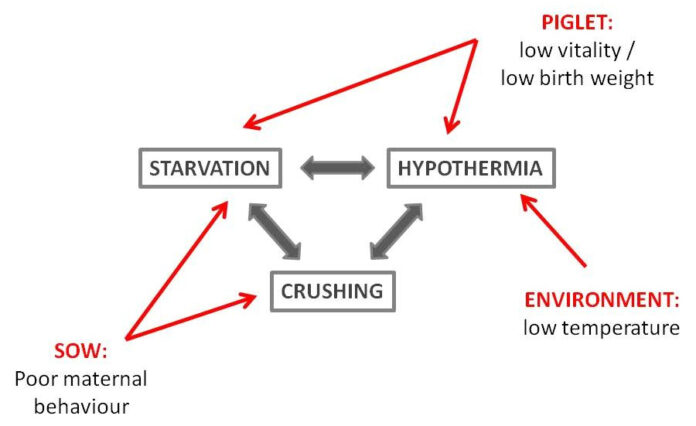Factors of pre-weaning mortality in pigs
- Chaudhari1, Jai Bhagwan2, Vikram Jakhar3
1 Extension Specialist, Pashu Vigyan Kendra, Sirsa, 2Assitant Professor, Lala Lajpat Rai University of Veterinary and Animal Sciences, Hisar
3Assitant Professor, Guru Angad Dev Veterinary and Animal Sciences University, Ludhiana
Pre-weaning mortality affects all herds and is brought on by congenital conditions that result in weak piglets, environmental factors, sow or piglet disease, and improper management of these conditions. Congenital factors include insufficient lung expansion, severe splay legs, congenital tremors, congenital infections with Leptospira or PRRS, navel bleeding, low birth weight, and a high birth rate, which result in fragility and poor viability. All can lead to failure of the piglet to reach a teat to suck colostrum or milk and to compete with the remainder of the litter for food. The piglet then dies of hypoglycaemia or is crushed.
Environmental factors include poor creep heating and poor arrangement of heaters so that piglets become chilled, bedding which traps piglets and allows crushing, lack of piglet drinkers and flooring which predisposes to foot lesions and arthritis.
Disease in the sow consists of systemic disease, death, agalactia or mastitis and acts largely through loss of milk, but may affect temperament and result in savaging. Disease in the piglet includes neonatal septicaemia, neonatal diarrhoea, septicaemia, arthritis and meningitis caused by Streptococcus suis or Haemophilus parasuis, greasy pig disease, coccidiosis and diseases such as TGE with high mortality in this age group.
Few important factors that cause pre-weaning mortality are explained here as follows:
- The hypothermia-starvation-crushing complex
Although several studies indicate that crushing by the sow is the ultimate cause of piglet death, crushing often results from the effects of perinatal hypothermia and starvation. Undernourished piglets spend more time close to the sow and are more likely to be crushed. The immune system of the newborn piglet is immature and consequently the acquisition of colostrum – the source of dietary energy which contains immunoglobulins for up to 36h after birth is essential. Furthermore, starvation is often secondary to, and interacts with, the effects of perinatal hypothermia, making piglets more lethargic, less competitive at the udder and less likely to achieve a sufficient colostrum intake. The lower critical temperature of newborn piglets is 34ºC and when ambient temperature is below 34 ºC piglets will attempt to gain heat shivering and huddling. One of the reasons why newborn piglets are so sensitive to cold is that they lack brown adipose tissue.
2. Piglet vitality and birth weight
The vitality of the piglet just after farrowing is crucial for survival when body reserves and thermoregulatory capacity are assured. Neonatal vitality can be accessed through behavioral observations, like as how long it takes an infant to reach the udder, and physiological indicators such muscle tone. Piglet vitality varies considerably between piglets of the same litter and this variation is influenced by the extent of hypoxia at birth. Last born piglets, or piglets from longer parturitions, are more likely to suffer hypoxia. Neonatal asphyxia incurs in severe acidosis and has severe negative effects on the function of vital organs. Reduced overall vitality, poor thermoregulation, failure of passive transfer of immunity, poor performance and greater susceptibility to infections are important secondary problems associated with neonatal asphyxia and acidosis.
Piglets with low birth weights have a higher mortality risk and gain less weight during breast feeding. For instance, piglets with a birth weight of less than 1 kg are more likely to die before weaning.
- Thermal Stress
One of the most significant stressors a pig experiences upon birth is the challenge to adapt to the thermal environment. Unlike many mammals, piglets do not possess brown adipose tissue, a type of fat that enables newborn animals to generate a great deal of heat to maintain body temperature. Thus, the piglet is required to stay close to the dam or a heat source to avoid hypothermia. The shivering response is used as a backup response for the piglet to generate heat in a cold environment.
The dam’s belly provides an excellent heat source for the newborn pig but positions it in a location in which it may easily become crushed; without an adequate substitute heat source crushing rates can be very high. The use of heat lamps has helped dramatically to move the pigs away from the belly of the sow and into a safe area to avoid crushing. Unfortunately, the piglets attraction to the heat lamp is not solidified until approximately day three after birth. It is during these first three days after parturition that most pre-weaning deaths occur. During the first three days after birth, piglets have a high attraction to the dams udder and relatively little attraction to the heat lamp. Research has shown that by transferring the odor of the dam to an area under the heat lamp the more piglets can be drawn to this safe area. More research on how to attract piglets into a safe area can help to reduce pre-weaning mortality.


